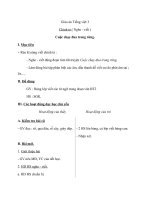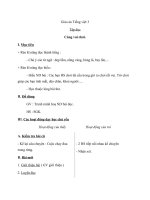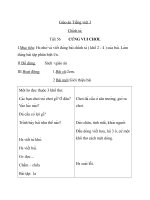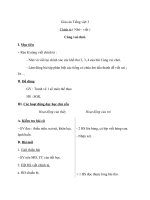Giáo án Tiếng Anh 3 tuần 28
Bạn đang xem bản rút gọn của tài liệu. Xem và tải ngay bản đầy đủ của tài liệu tại đây (122.67 KB, 8 trang )
<span class='text_page_counter'>(1)</span><div class='page_container' data-page=1>
Date of preparing: 04/06/2020 Week 28
Period 107
<b>UNIT 20: WHERE’S SAPA?</b>
<i><b>Lesson 3: Part 1-2-4-5</b></i>
<b>I. Objectives:</b>
<i><b>1. Knowledge: </b></i>
By the end of the lesson Ps will be able to: pronounce the sounds of the letters ar and or
in the words far and north respectively
<i><b>2. Skills: </b></i>
- Develop Ss speaking and listening skills
<i><b>3. Attitude: Educate Sts to love their lesson. </b></i>
Work hard
<b>II. TEACHING AIDS:</b>
<i>1. Teacher’s: student’s and teacher’s book, pictures, cassette.</i>
<i>2. Students’: books, notebooks, workbooks.</i>
<b>III. TEACHING METHODS:</b>
- Work in pairs , individual, in groups ….
<b>IV. PROCEDURE:</b>
<i><b>1. Class organization</b><b> :</b><b> </b></i>
- Greeting: Good morning/ Good afternoon. How are you?
- Checking for the students’ attendence:
Class Date of teaching Absent Students
3A
3B
3C
3D
09/06/2020
10/06/2020
10/06/2020
11/06/2020
……….
……….
……….
……….
<i><b>2. Warm up :3’</b></i>
Chatting
3. New lesson
Teacher’s and students’ activities Content
<b>* Activity 1: (8’)</b>
Tell pupils that they are going to practise saying the
letters, words and sentences in the book.
Put the phonics letters arand oron the board and say
them a few times. Ask pupils to repeat after you.
Prompt pupils to say the words and sentences, paying
attention to the target phonics letters. Do choral
repetition of the words and sentences until pupils feel
confident.
<b>1. Listen and repeat.</b>
<b>* Activity 2: (8’)</b>
- Tell pupils that they are going to do a dictation. Give
pupils a few seconds to read the text in silence before
starting the dictation.
• Have pupils swap and check their answers before
</div>
<span class='text_page_counter'>(2)</span><div class='page_container' data-page=2>
checking as a class. Write the correct answers on the
board for pupils to copy down into their notebooks.
• Get pupils to work in pairs and practise saying the
sentences.
Key: 1 far 2north
<b>* Activity 3: (8’)</b>
Tell pupils that they are going to read the text and
answer the questions about A Vung and his place. Give
pupils a few seconds to look at the picture and read the
text in silence. Check comprehension and give
feedback. Explain the meaning of the new vocabulary.
• Give pupils time to do the task. Go around to offer
help, if necessary.
• Give time for pupils to swap and check their answers
before checking as a class.
• Do choral repetition of the questions and answers.
Key: 1His family is in Sa Pa. 2 He’s eight (years old).
3 It’s in north Viet Nam. 4 No, it isn’t. It’s far from Ha
Noi.
<b>4. Read and write </b>
Key: 1His family is in Sa
Pa. 2 He’s eight (years old).
3 It’s in north Viet Nam. 4
No, it isn’t. It’s far from Ha
Noi.
<b>* Activity 4: (9’)</b>
Tell pupils that they are going to answer the questions
about themselves. Give a few seconds for pupils to read
the questions in silence. Check comprehension and give
feedback.
• Give time for pupils to do the task. Get weaker pupils
to work in pairs.
• Get pupils to swap and check their answers before
calling on pupils to read aloud their answers.
Key: Pupils’ own answers
5. Read and write
Key: Pupils’ own answers
<i><b>4. Consolidation: (2’)</b></i>
What’s the content of the lesson? Or What have you learnt today?
<i><b>5. Homelink: (1’)</b></i>
Do exercises in the workbook. Review the model sentences and the new words.
<i><b>6. Comments:</b></i>
………
………
………
Period 108
<b>REVIEW 4</b>
<b>I. Objectives:</b>
</div>
<span class='text_page_counter'>(3)</span><div class='page_container' data-page=3>
• read and identify specific information.
• read and identify general ideas.
<b>Sentence patterns: Review</b>
<b>Vocabulary: Review</b>
<i><b>2. Skills: </b></i>
- Develop Ss reading, writing and listening skills
<i><b>3. Attitude: Educate Sts to love their lesson. </b></i>
Work hard
<b>II. TEACHING AIDS: </b>
<i>1. Teacher’s: student’s and teacher’s book, pictures, cassette.</i>
<i>2. Students’: books, notebooks, workbooks.</i>
<b>III. TEACHING METHODS:</b>
- Work in pairs , individual, in groups ….
<b>IV. PROCEDURE:</b>
<i><b>1. Class organization</b><b> :</b><b> </b></i>
- Greeting: Good morning/ Good afternoon. How are you?
- Checking for the students’ attendence:
Class Date of teaching Absent Students
3A
3B
3C
3D
09/06/2020
10/06/2020
10/06/2020
11/06/2020
……….
……….
……….
……….
<i><b>2. Warm up :7’</b></i>
Aks ss some questions to review words, structures…
3. New lesson
Teacher’s and students’ activities Content
<b>* Activity 1: (12’)</b>
Tell pupils that they are going to listen and tick the
correct boxes. Give pupils a few seconds
to look at the pictures. Check comprehension and elicit
information in the pictures and give
feedback.
• Play the recording three times for pupils to listen, do
the task and check their answers.
• Get pupils to swap and check their answers before
checking as a class. Explain the answers
and give further support to pupils who got more than
half of the answers wrong.
Audio script
1. Tom: Do you have a pet?
Mai: Yes, I do. I have a goldfish.
2. Linda: How many parrots do you have?
Mai: I have two.
3. Mai: Hello, Mai’s speaking.
</div>
<span class='text_page_counter'>(4)</span><div class='page_container' data-page=4>
Linda: Hello, Mai. It’s Linda.
I’m in Da Nang now.
Mai: Great! It’s raining in Ha Noi.
What’s the weather like in Da Nang?
Linda: It’s sunny.
4. Quan’s mother: Where are your brother
and sister, Quan?
Quan: They’re in the garden.
Quan’s mother: What are they doing there?
Quan: They’re skipping.
5. Tony: Where is this place, Nam?
Nam: It’s in north Viet Nam.
<b>* Activity 2: (12’) </b>
• Tell pupils that they are going to listen and number
the correct boxes. Give pupils a few
seconds to look at the pictures. Check comprehension
and elicit information in the pictures
and give feedback.
• Play the recording three times for pupils to listen, do
the task and check their answers.
• Get pupils to swap and check their answers before
checking as a class. Explain the answers
and give further support to pupils who got more than
half of the answers wrong.
Audio script
1. Tony: What’s your father doing?
Mai: He’s watching TV.
3. Tony: How many kittens do you have ?
Nam: I have four.
2. Tony: Do you have any toys?
Nam: Yes, I do. I have three kites.
3. Tony: How many kittens do you have ?
Nam: I have four.
4. Mai : What’s your mother doing?
Linda: She’s cooking
<b>2. Listen and number: </b>
Key: a2 b3 c4 d1
<i><b>4. Consolidation: (2’)</b></i>
What’s the content of the lesson? Or What have you learnt today?
<i><b>5. Homelink: (2’)</b></i>
Do exercises in the workbook. Learn by heart the new words.
<i><b>6. Comments:</b></i>
</div>
<span class='text_page_counter'>(5)</span><div class='page_container' data-page=5>
Period 109
<b>REVIEW 4-cont</b>
<b>I. Objectives:</b>
<i><b>1. Knowledge: By the end of lesson, pupils can: listen and identify specific information.</b></i>
• read and identify specific information.
• read and identify general ideas.
<b>Sentence patterns: Review</b>
<b>Vocabulary: Review</b>
<i><b>2. Skills: </b></i>
- Develop Ss speaking and listening skills
<i><b>3. Attitude: Educate Sts to love their lesson. </b></i>
Work hard
<b>II. TEACHING AIDS: </b>
<i>1. Teacher’s: student’s and teacher’s book, pictures, cassette.</i>
<i>2. Students’: books, notebooks, workbooks.</i>
<b>III. TEACHING METHODS:</b>
- Work in pairs , individual, in groups ….
<b>IV. PROCEDURE:</b>
<i><b>1. Class organization</b><b> :</b><b> </b></i>
- Greeting: Good morning/ Good afternoon. How are you?
- Checking for the students’ attendence:
Class Date of teaching Absent Students
3A
3B
3C
3D
11/06/2020
12/06/2020
11/06/2020
12/06/2020
……….
……….
……….
……….
<i><b>2. Warm up :3’</b></i>
Spend a few minutes revising the previous lesson by playing Spot the odd one out.
Follow the procedure in Games in introduction. You may use the names of the places
and phrases of future plans that ps have learnt in the previous lesson.
3. New lesson
Teacher’s and students’ activities Content
<b>* Activity 1: 10’</b>
- Tell pupils that they are going to read the text and fi ll
the gaps. Give a few seconds for pupils to
read the text in silence. Check comprehension.
• Give pupils time to do the task.
• Get pupils to swap and check their answers before
checking as a class.
• Do choral and individual repetition of the text.
</div>
<span class='text_page_counter'>(6)</span><div class='page_container' data-page=6>
<b>* Activity 2: 10’</b>
Tell pupils that they are going to read the sentences on
the left and pair them with those on
the right by drawing a line between them. Give a few
seconds for pupils to read in silence.
Check comprehension and give feedback.
• Give pupils time to do the task.
• Get pupils to swap and check their answers before
checking as a class.
• Have a few pairs act out the dialogues.
Key: 1e 2c 3a 4b 5d
<b>4. Read and match</b>
Key: 1e 2c 3a 4b 5d
<b>* Activity 3: 8’</b>
- Tell pupils that they are going to answer the
questions. Give a few seconds for pupils to look
at the pictures and read the text in silence. Check
comprehension by eliciting the words to
answer the questions and give feedback.
• Get pupils to work in pairs. Go around to off er help,
if necessary.
• Call a few pairs to act out the dialogues. Give
feedback and praise pupils who did well and
encourage pupils to listen and make improvement.
<b>5. Look and say</b>
<i><b>4. Consolidation: (2’)</b></i>
What’s the content of the lesson? Or What have you learnt today?
<i><b>5. Homelink: (2’)</b></i>
Do exercises in the workbook. Learn by heart the new words.
<i><b>6. Comments:</b></i>
………
………
………
Period 110
<b>SHORT STORY: CAT AND MOUSE 4</b>
<b>I. Objectives:</b>
<i><b>1. Knowledge: At the end of the period, pupils will be able to: read, listen to and</b></i>
understand a short story, have a conversation with partners, using a script.
Sentence patterns: revision
Vocabulary: revision
<i><b>2. Skills: </b></i>
</div>
<span class='text_page_counter'>(7)</span><div class='page_container' data-page=7>
<b>II. TEACHING AIDS: </b>
<i>1. Teacher’s: student’s and teacher’s book, pictures, cassette.</i>
<i>2. Students’: books, notebooks, workbooks.</i>
<b>III. TEACHING METHODS:</b>
- Work in pairs , individual, in groups ….
<b>IV. PROCEDURE:</b>
<i><b>1. Class organization</b><b> :</b><b> </b></i>
- Greeting: Good morning/ Good afternoon. How are you?
- Checking for the students’ attendence:
Class Date of teaching Absent Students
3A
3B
3C
3D
11/06/2020
12/06/2020
11/06/2020
12/06/2020
……….
……….
……….
……….
<i><b>2. Warm up :3’</b></i>
Spend a few minutes revising the previous lesson by calling three groups of fourps to the
front of the class to play the game Say where.
3. New lesson
Teacher’s and students’ activities Content
<b>* Activity 1: (11’)</b>
Tell pupils that they are going to read and listen to
the story. Before pupils listen, ask them to look at the
pictures and ask them questons (e.g. What are
Maurice and Doris doing in picture 5 to 6?)
Play the tape and let the pupils read and listen.
<b>1. Read and listen to the </b>
<b>story</b>
<b>* Activity 2: (7’)</b>
Tell pupils that they are going to put the words in the
correct order to make sentences. Give a
few seconds for pupils to read the text.
• Give time for pupils to do the task.
• Ask pupils to swap and check their sentences before
checking as a class.
• Ask a few pairs to read aloud the correct sentences.
Key: 1Let’s go for a walk.
2Let’s read a book.
3What are they doing?
4Nini is listening to music.
<b>2. Work in pairs</b>
Key: 1Let’s go for a walk.
2Let’s read a book.
3What are they doing?
4Nini is listening to music.
<b>Activity 3: 5’</b>
- Tell pupils that they are going to pair the words that
rhyme. Explain to pupils that rhyming
words are and give them some examples (e.g. fine
and line). Give a few seconds for pupils to
read the words in the book.
<b>3. Match the rhyming </b>
<b>words</b>
</div>
<span class='text_page_counter'>(8)</span><div class='page_container' data-page=8>
• Give time for pupils to do the task.
• Get pupils to swap and check the answers before
checking as a class.
• Ask a few pupils to read aloud the pairs of rhyming
words.
<b>Activity 4: 4’</b>
Tell pupils that they are going to read the text and fill
the gaps. Give a few seconds for pupils
to read the text and check comprehension.
• Give time for pupils to do the task.
• Get pupils to swap and check the answers before
checking as a class.
• Ask a few pairs to read aloud the dialogue.
Key: 1 are you 2 fine 3 like 4 I do 5 I don't
<b>4. Read and write</b>
Key: 1 are you 2 fine 3
like 4 I do 5 I don't
<i><b>4. Consolidation: (2’)</b></i>
What’s the content of the lesson? Or What have you learnt today?
<i><b>5. Homelink: (2’)</b></i>
Do exercises in the workbook. Learn by heart the new words.
<i><b>6. Comments:</b></i>
</div>
<!--links-->









